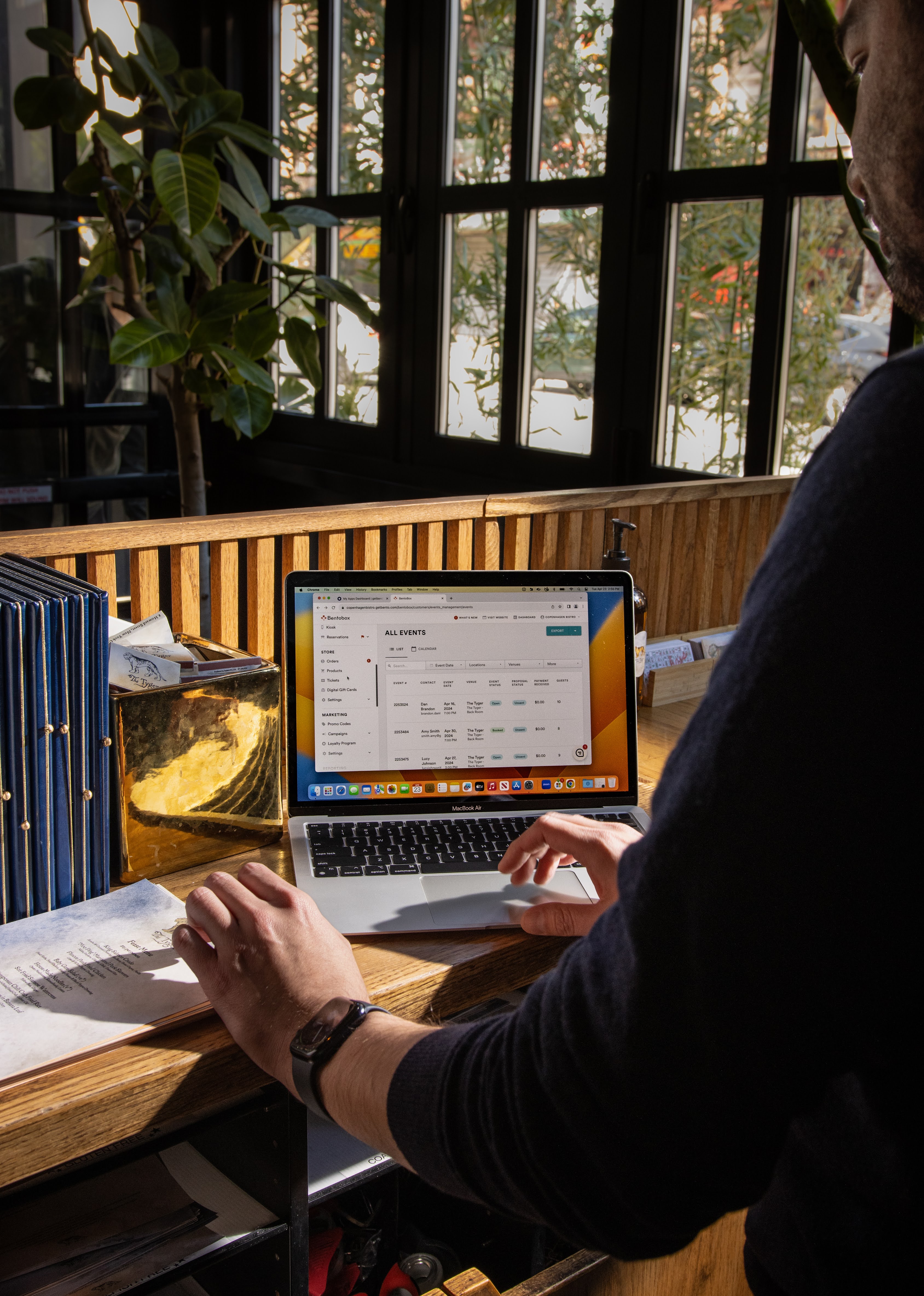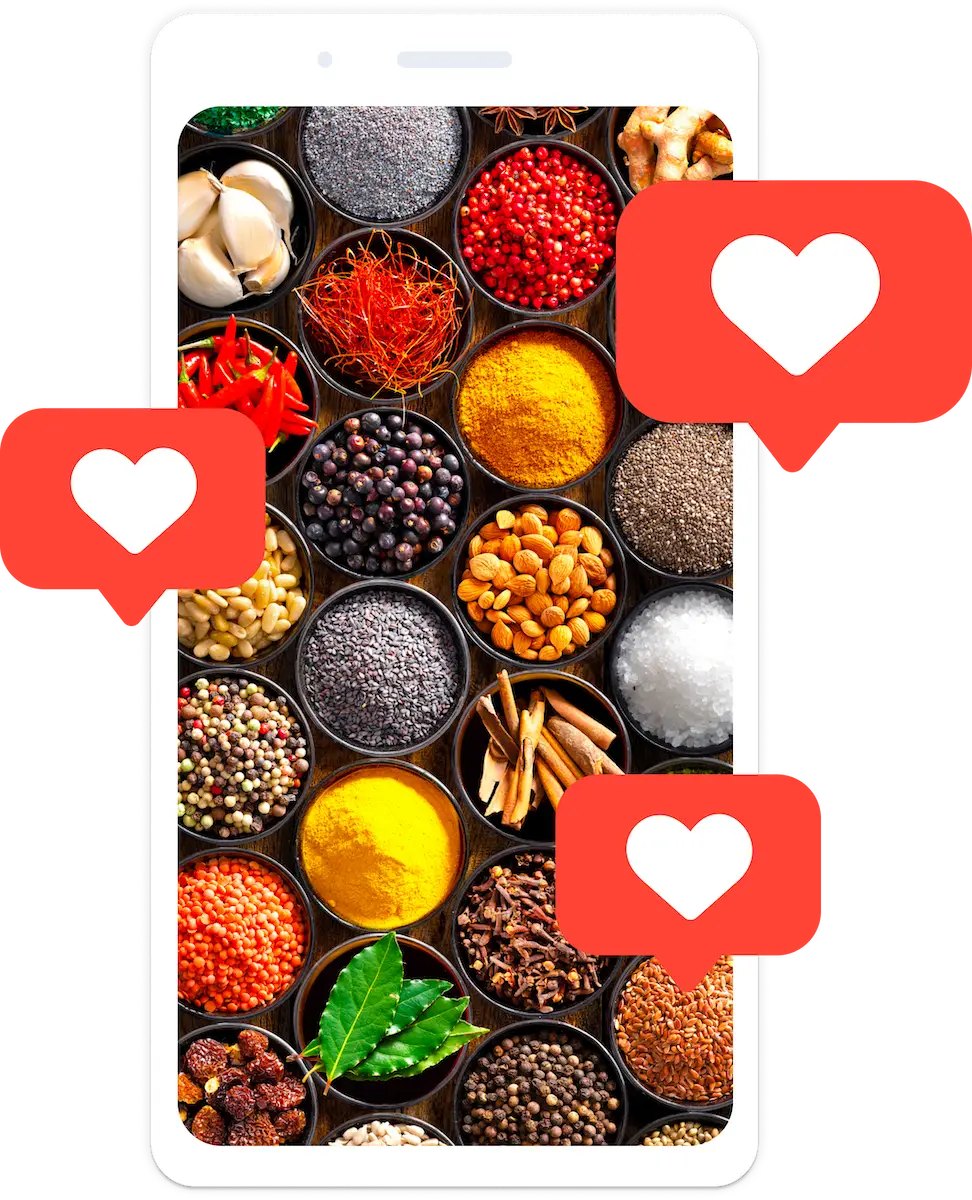Marketing
How Restaurants Should Use Instagram in 2024
Instagram remains the most important social platform for restaurants. Here’s how to find success.
In 2024, Instagram is still a restaurant’s best social media asset. Content can be anything from a quick 24-hour Instagram Story that promotes tonight’s special to a lengthy Instagram Reel that lives on a restaurant’s profile forever. The visual nature of Instagram goes hand-in-hand with restaurant marketing in that diners are vying for pictures of food, videos of staff and Stories promoting limited-time offerings.
Here’s how to embrace Instagram for restaurant marketing, plus some practical tips and examples for being successful.
Why Should Restaurants Use Instagram?
With approximately 2.35 billion monthly active users — including 40% of the U.S. population — Instagram is the fourth-largest social media site behind Facebook, YouTube and WhatsApp. While Instagram’s reputation might suggest it’s mostly used by teens and young adults, 71% of people aged 18-29 and 48% of people aged 30-49 have active Instagram accounts. This cohort of users includes young professionals, parents with disposable income, men and women — pretty much anyone you would want to come to your restaurant.
Instagram is an ideal platform for restaurants to have in their marketing arsenal since there’s no shortage of drool-worthy content coming out of the kitchen at any given moment. Among consumers, there’s a hunger for food photography and restaurants are perfectly poised to satisfy that interest. Other content ideas to dabble in as well are highlighting staff, sharing news and promoting special offers.
All of these ingredients make it not only possible but likely for restaurants to amass an audience on Instagram, provided they follow best practices. It’s not uncommon for restaurants to gain thousands of followers on the platform— check out Death & Co, Misi, and PLANTA, which all have more than 100,000 Instagram followers.
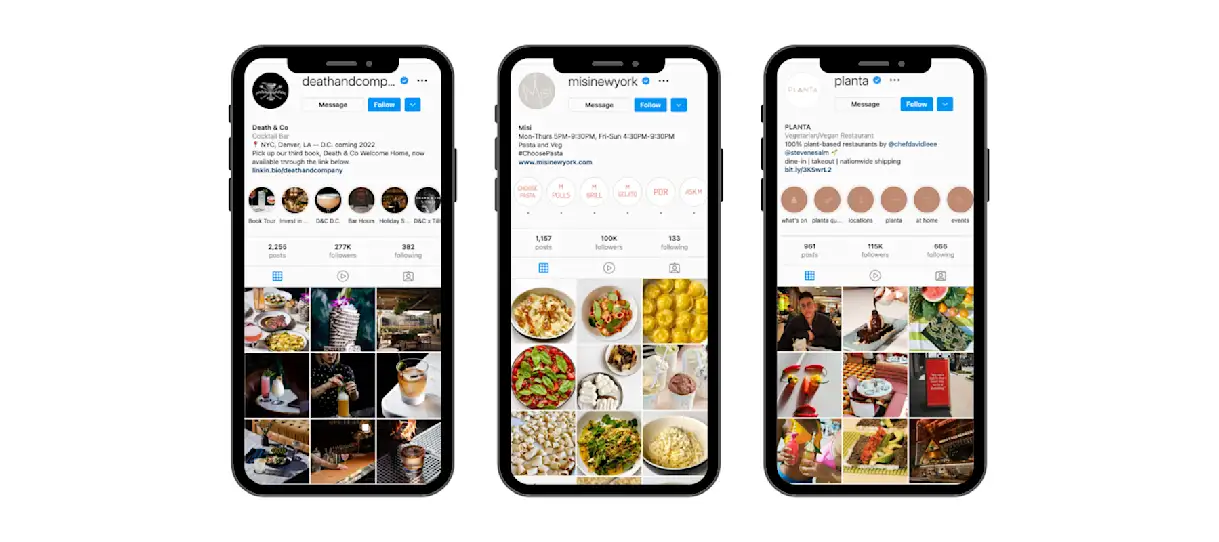
In short, loyal fans are more than willing to give their favorite restaurants a follow — and having an optimized and active profile can help someone unfamiliar with a restaurant add it to their list of places to try.
How To Optimize Your Instagram Profile
Creating a profile on Instagram simply requires a photo to be uploaded and a few fields to be filled out. Here are some key pointers:
1. Keep your name and username simple.
The name of your Instagram profile should be your restaurant’s name to maximize searchability on the platform Your username should be as close to your restaurant’s name as possible. If the name is taken, a variation on the name is appropriate. For example, if @SarahsPastries is taken, then @SarahsNYC or @Sarahs_Pastries would work.
2. Be strategic about your website link.
The website field should link to your restaurant’s website, although linking straight to the direct online ordering page can make it easier for diners to place an order. Alternatively, restaurants can set up a Linktree or a Link in Bio. Since individual posts can’t use clickable URLs, a Linktree or Link in Bio account allows users to assign links to each post and share one main link in this field.
3. Write a short, but intentional bio.
Your bio should be a short intro to your restaurant, location(s) and cuisine type. You can also mention your hours or any news like special offerings or upcoming openings.
Here are a few examples:
Souvla: “A group of fast-fine 🇬🇷 restaurants with locations throughout San Francisco. New locations coming soon!”
The Good King Tavern: “Cozy neighborhood spot slinging French tavern fare, cocktails & lots of 🍷. Mon-Fri 5-11 | Sat 3-11 (food ‘til 10)”
St. Anselm DC: “Devoted to the pleasure of grilled fare, great ingredients, funky wines + cocktails. Now open Fridays for lunch.”
4. Make sure you have a business profile.
Your account should be a business profile. Although the standard option of “Restaurant” works, there’s an option to get more specific with designations like “Barbecue Restaurant” or “Ice Cream Shop.”
Read more: How to set up a business account on Instagram
Here’s an example of a perfectly optimized Instagram profile from Cabra Chicago that’s filled with a descriptive bio (including mention of their chef and restaurant group), a branded Link in Bio and saved Stories across the top with custom designs.
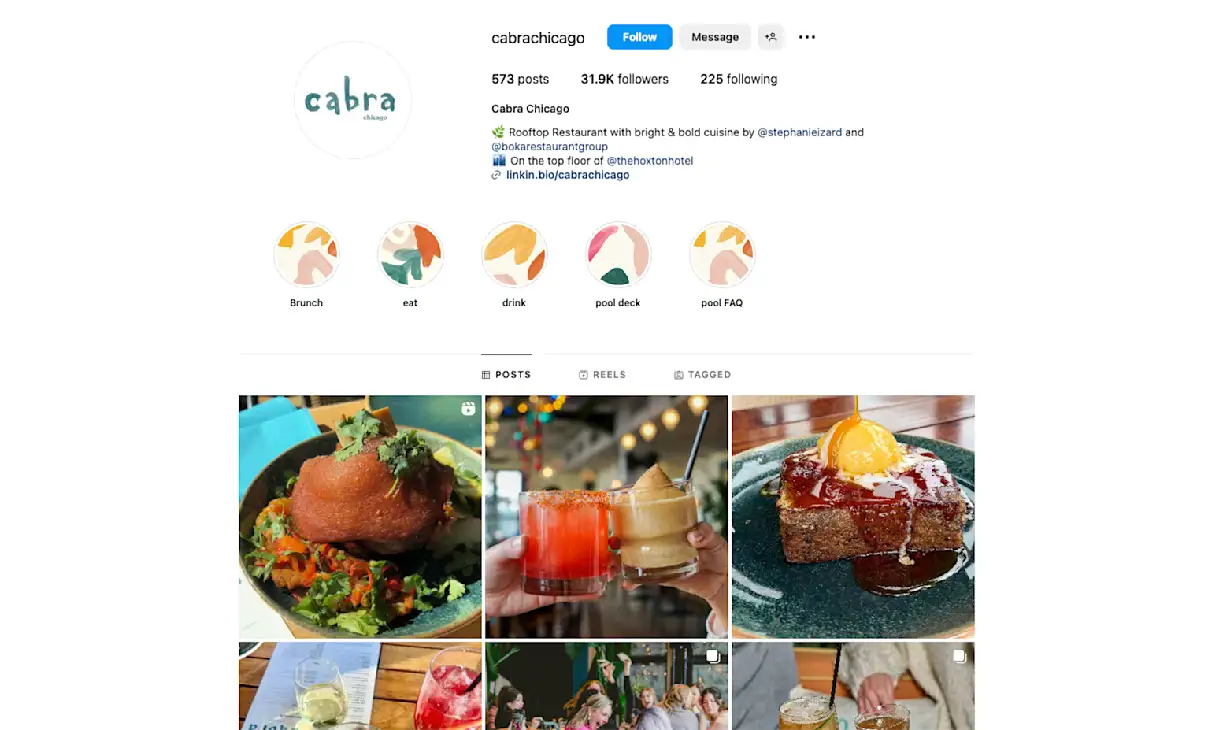
Types of Instagram Content
There are four main types of content that users can share on Instagram, each with different purposes and benefits.
Instagram Posts
This is the classic image or video that, when posted, will show up on the main feed of anyone following the restaurant.
“I seldom post a static image on its own,” said Colleen Daly, Senior Social Media Manager for Boka Restaurant Group. “I prefer using a carousel for additional engagement whenever possible—swipe, swipe, swipe = more engagement.”
Instagram Stories
Stories are short-lived videos or images that can last up to ten seconds. They provide an aura of immediacy since after 24 hours, followers can no longer see them.
Instagram Reels
These are longer-form videos that can be edited with audio and multiple clips. They’re comparable to TikTok videos.
Instagram Live
Users can go live for up to four hours. Restaurants can use this time to show real-time, day-in-the-life content of staff or the cooking process for a favorite dish.
Wondering what types of content you should be posting? Aim for variety.
“We mix it all! Static posts showcase our brand identity and ensure consistency; stories provide timely updates and audience interaction, while reels offer entertainment, and so on,” said Samantha Fryzol, Marketing Manager for STARR Restaurant Group. “Our decisions on each format are guided by campaign goals, audience engagement patterns, and current trends.”

RESOURCE
25 Creative Restaurant Instagram Ideas
Inspiration from the largest restaurant social accounts, with advice on how to apply it to your own strategy.
8 Restaurant Instagram Marketing Ideas
Instagram to the uninitiated can be overwhelming. To get started, here are eight simple ways to create and share content on a restaurant Instagram profile.
1. Repurpose user-generated content.
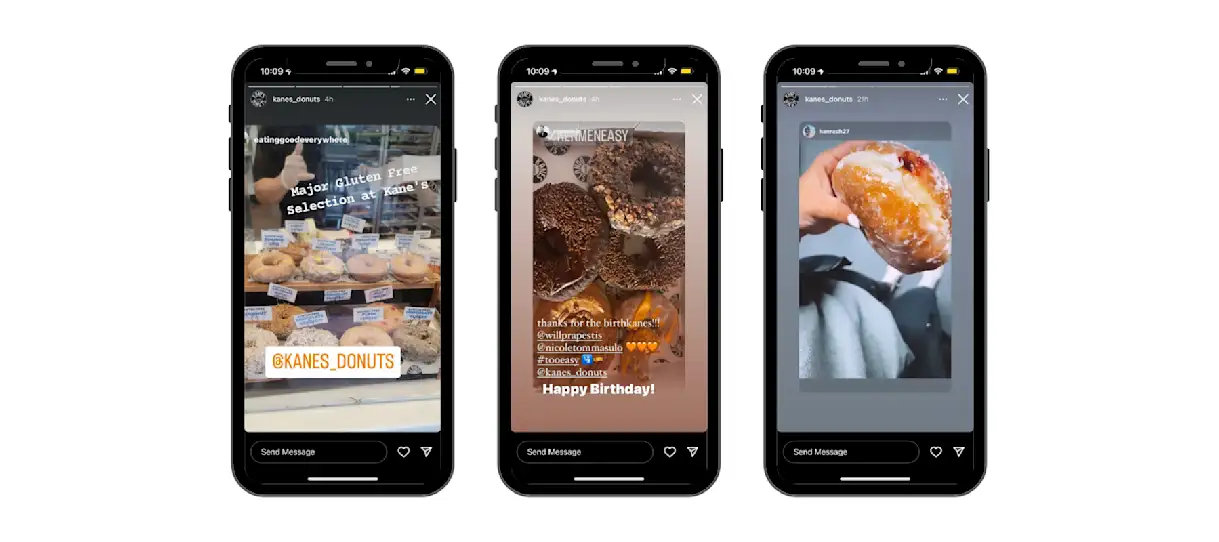
Example: Kane’s Donuts
Too busy to take the perfect photo for Instagram? Don’t worry — customers aren’t. Nearly 70% of millennials take a photo of their food before they eat it, and when they post it on Instagram, they’re often tagging the restaurant where they ordered.
In this case, the restaurant will get a notification that they’ve been tagged, and then have the option to share the content to their Stories.
Constantly sharing user-generated content ensures the restaurant’s Stories stays fresh on a user’s timeline and encourages followers to post (and tag the restaurant) the next time they visit in hopes of getting shared themselves. Resharing images and videos takes seconds and ensures a steady stream of content.
“ I thank every user who tags the page for the content they’ve shared. Guests advocating for your space, or sharing that they’ve enjoyed their time with you is major!” said Alli DelGrippo, Event Manager for The Good King Tavern, le Caveau: bar à vins, and Superfolie.
“And when a guest shares something that fits the energy of the brand/page/restaurant/food + wine programs, it’s a good opportunity to chat with them, thank them for coming in, for spending time with us, and I ask if we can reshare with credit to them for their shot. It doesn’t always get shared immediately, but it’s in the arsenal for the perfect moment.”
2. Introduce your restaurant staff.
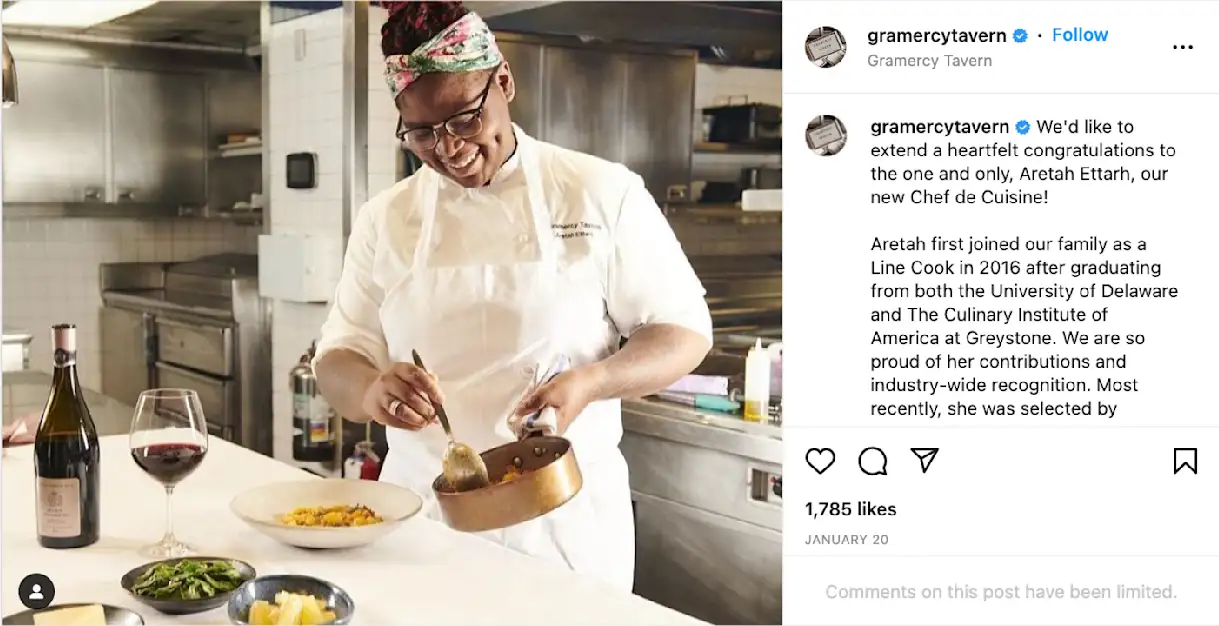
Example: Gramercy Tavern
Cooks and managers — who are often busy behind kitchen doors or in back offices — rarely get a spotlight, even though their work is integral to a restaurant’s success. Why not use Instagram to celebrate these hard workers?
Staff highlights come in many forms. At high-end eateries, a formal introduction of who masterminded the meal adds a personal touch to the dining experience. New York’s Gramercy Tavern does this in the example above, highlighting the Chef de Cuisine’s role, education and accomplishments. More casual restaurants might want to do a less formal staff intro, or even sit them down for a Q&A for an Instagram Story or Live.
Read more: 11 Restaurant Employee Appreciation Ideas
3. Promote upcoming events.
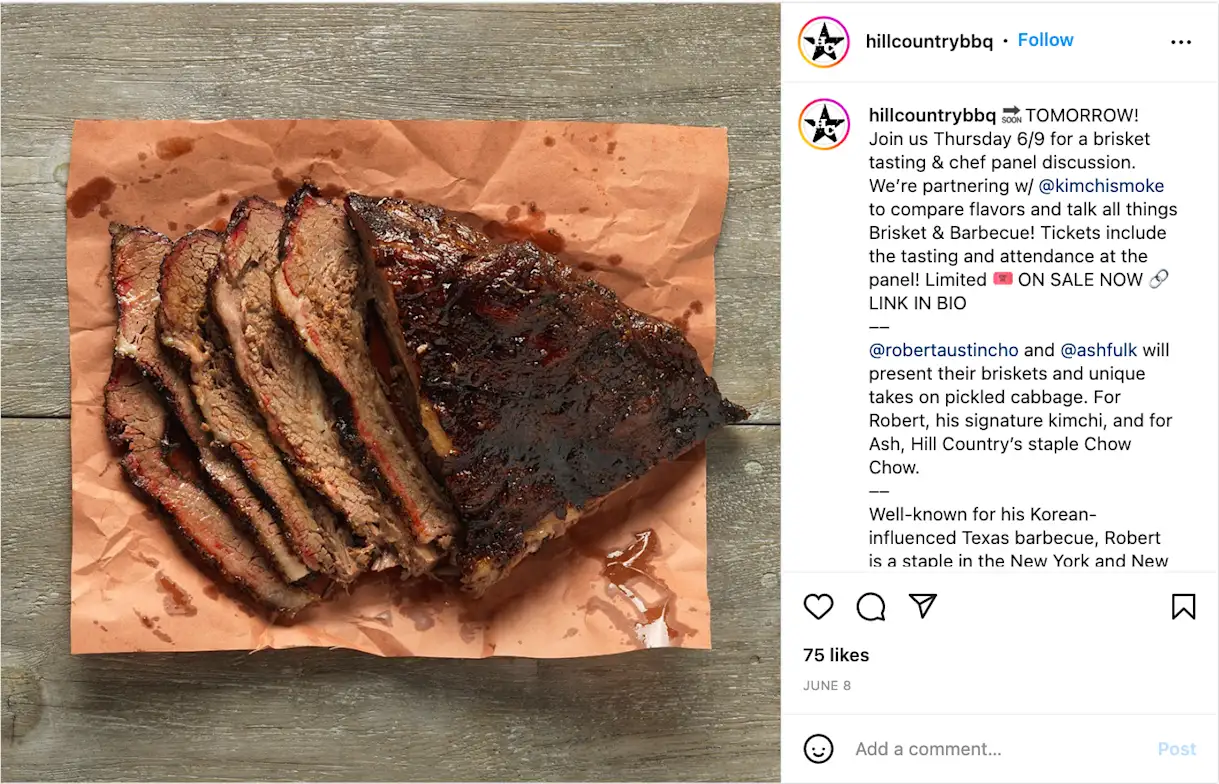
Example: Hill Country BBQ
Restaurants that host events have a free marketing channel thanks to Instagram. For open events like themed nights or game airings, restaurants can post about them days or weeks leading up to the event, as well as share Stories to encourage last-minute arrivals.
For ticketed events that require registration, restaurants can not only post about them — they can link to a ticket purchasing site right from their Instagram profile. In the above example from Hill Country, the caption outlines when and where the event is with a callout to the ticket link, followed by more details on what the event entails. This example is accompanied by a mouth-watering picture of brisket, but events can also be promoted using custom graphics made on a design tool like Canva.
4. Embrace holiday marketing.
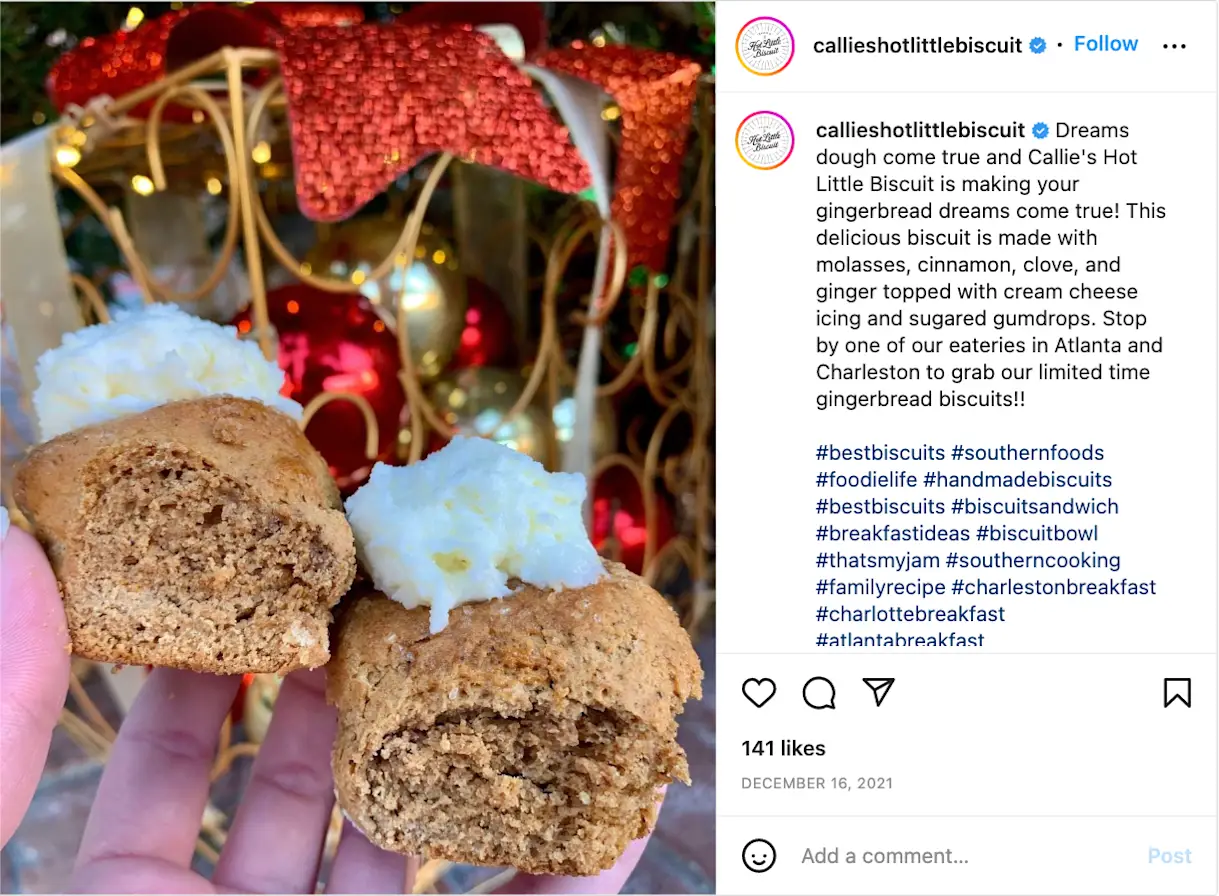
Example: Callie’s Hot Little Biscuit
Holidays are a perfect excuse to get into the festivities on Instagram. Whether it’s the Fourth of July or Christmas, restaurants can post creative videos and images to promote holiday menu specials, private party availability, catering options, holiday merch sales or gift card deals in a timely way.
In the example above, Callie’s posted an image of their signature biscuits with a Christmas-themed backdrop to catch followers’ eyes. When looking at the caption, it’s specified that these are (limited-time) gingerbread biscuits. The post went live with ten days to spare before Christmas, combining the urgency to try these specials before they’re gone with a holiday theme to the content itself.
5. Sell swag and merch.
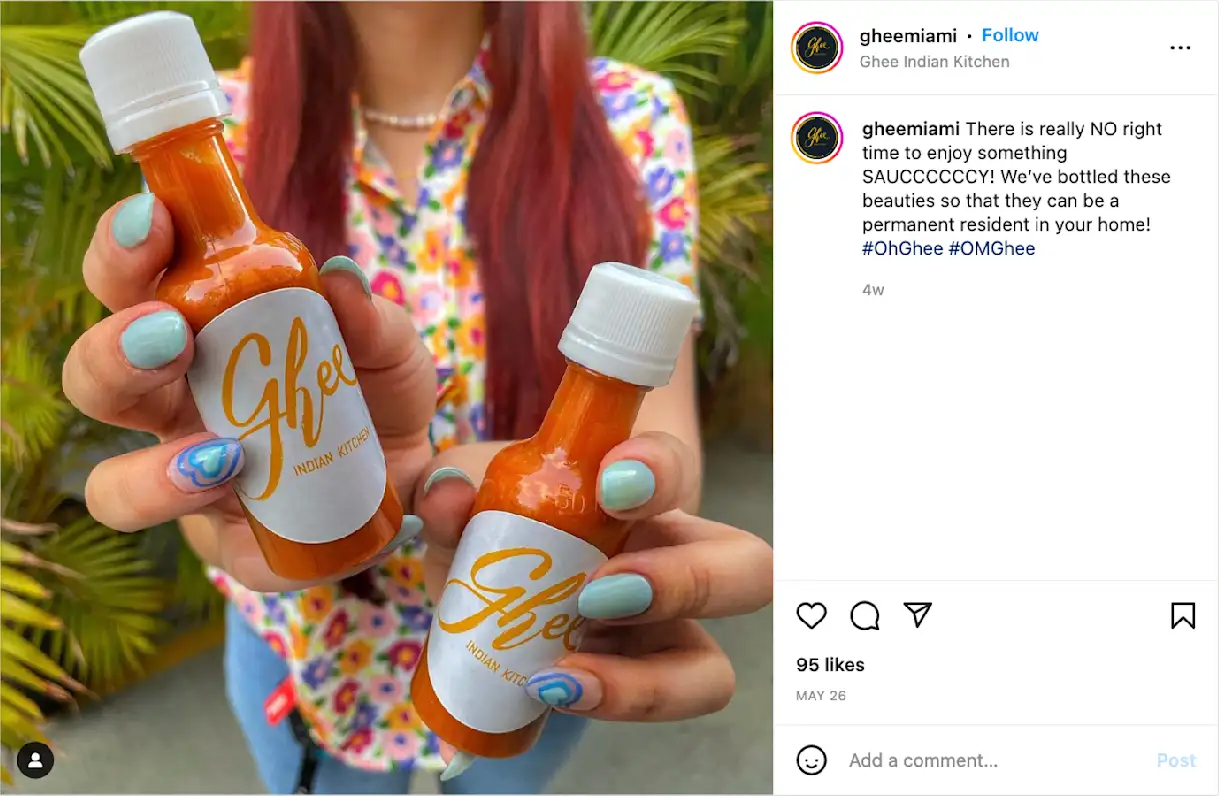
Example: Ghee Indian Kitchen
Some patrons — particularly those who tend to order online — might not even know that their favorite restaurant has merchandise they can buy. From t-shirts and hats to seasonings and bottled sauces, Instagram is where a restaurant can share these items’ availability to a group of followers who are the most likely to make the purchase.
Restaurants with an online merchandise store hosted on their website can send followers straight to an ecommerce page where they can order this merch for delivery or pickup.
Read more: 10 Most Popular Restaurant Merchandise Ideas
6. Encourage engagement and comments.
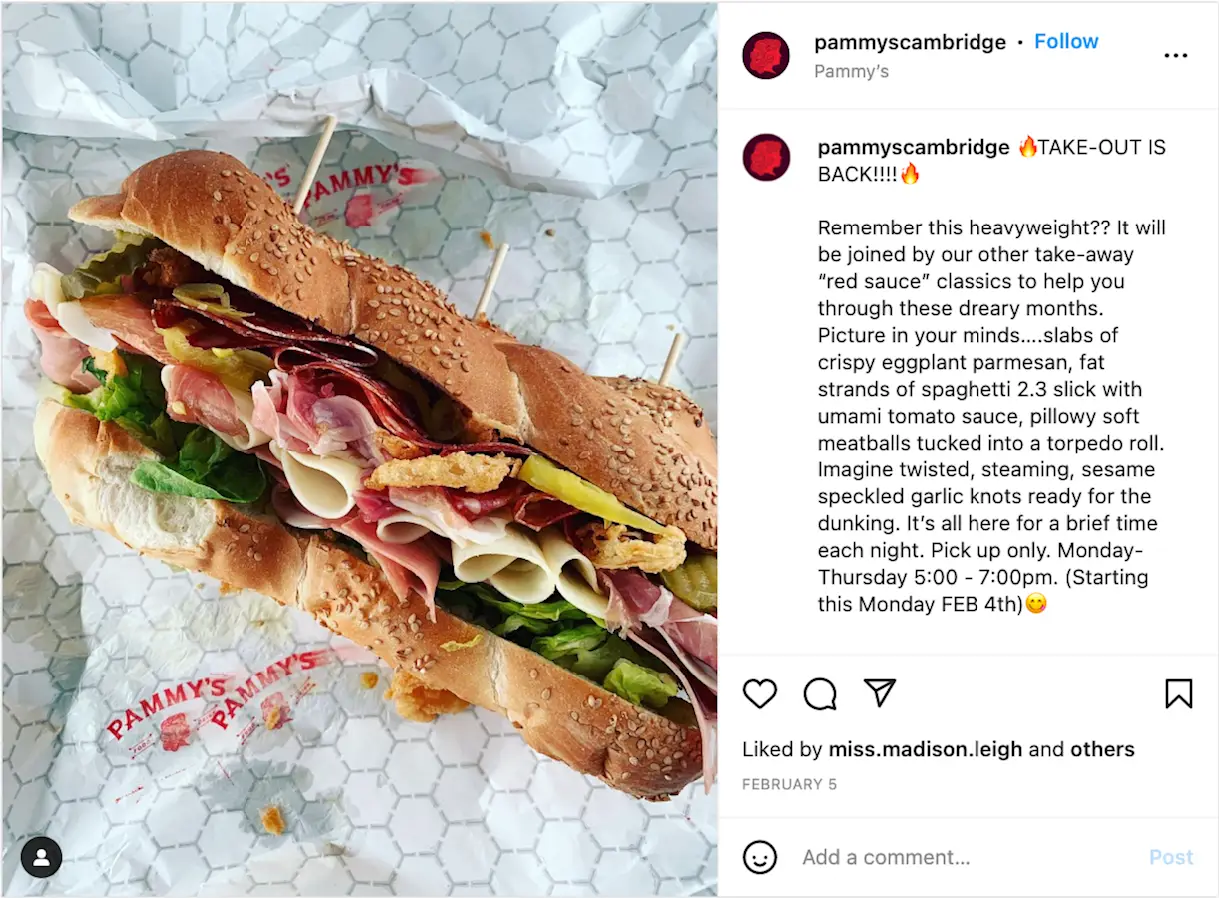
Example: Pammy’s
Posts that get high engagement through likes and comments are more likely to find an audience on Instagram’s algorithm, so restaurants should be encouraging this engagement in a natural way.
Having “comment below!” or “like this post!” in every caption isn’t the move here. Instead, follow the example above set by Pammy’s. They announced that their takeout menu was back and posted a super tasty looking hero sandwich with a prompt to “Tag a friend you’d like to get cozy and share a HERO with!” The post received lots of engagement and chatter in the comments.
7. Announce new and limited-time menu items.
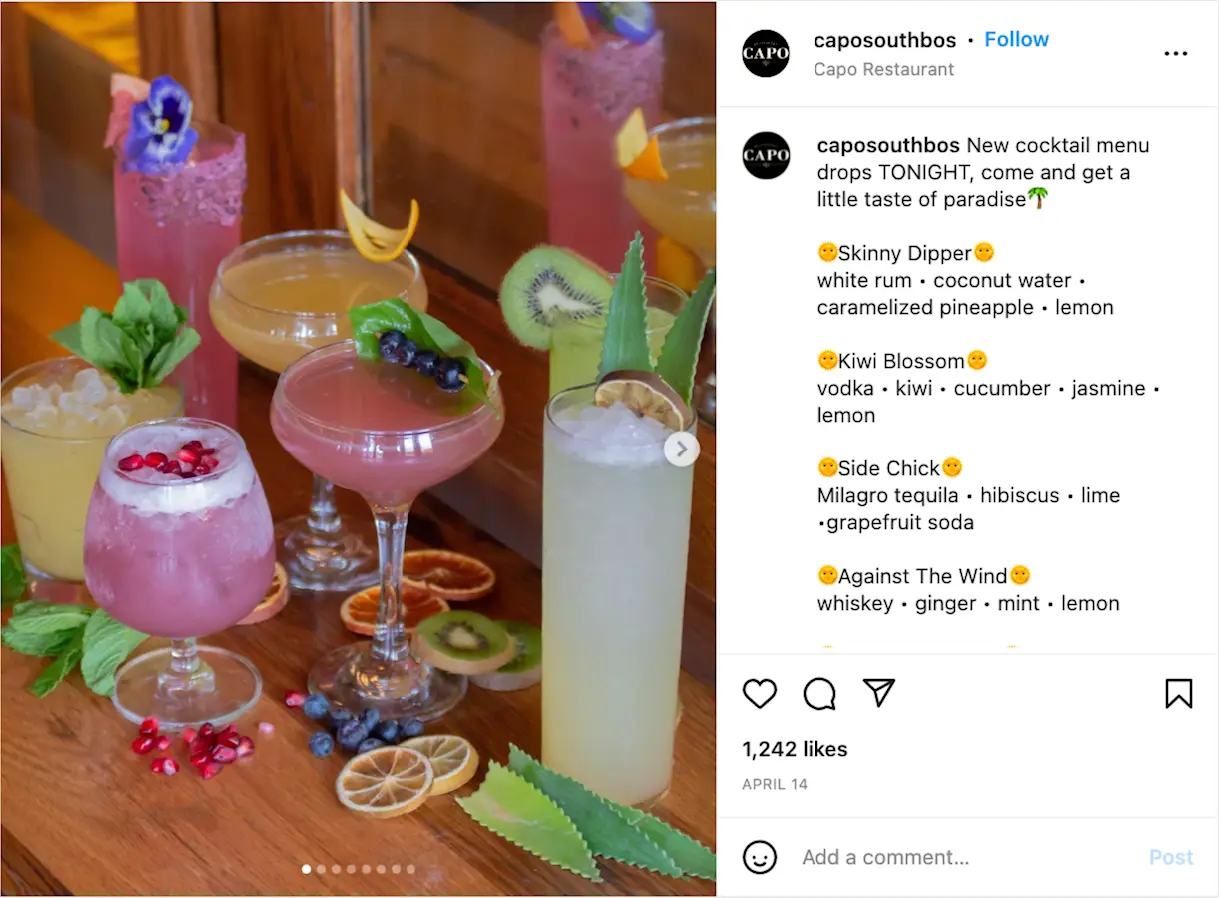
Example: Capo
When a restaurant introduces a new item to its menu, it can be hard to sell the value with just words. That’s where Instagram can help. Restaurants can add a post sharing an image of the new menu item, describing what makes it special and explaining how long it’s available for. Stories also make sense for daily specials, as they can be set to expire before the next day’s shift.
In this example, Capo uses an Instagram carousel to show a photo of all the drinks on their new cocktail menu and you can tap through to see individual shots of each sipper with a description in the caption.
8. And when all else fails, just post food photos.
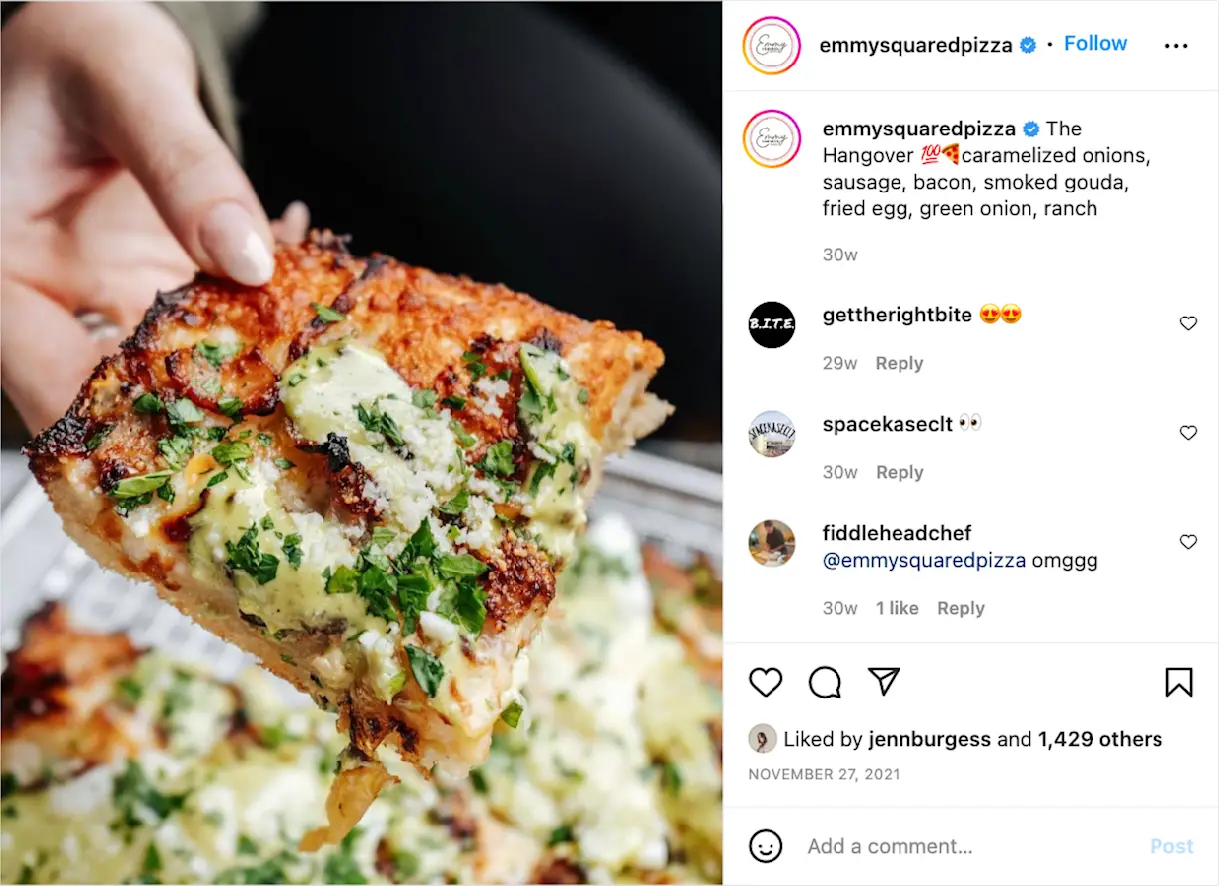
Example: Emmy Squared
It’s vital for restaurants to use their Instagram presence to turn follows into purchases, but follows will only come if an Instagram account posts the content people follow for — awesome pictures of delectable-looking food.
The Instagram profile for Emmy Squared has plenty of promotions, discounts and event reminders. However, they’re intertwined with close-up shots of their mouthwatering pizza and sandwiches. These are the posts that bring in and retain followers so that when the restaurant posts more promotional content, they reach a wider audience. When applying the Pareto Principle (or 80/20 rule) to an Instagram strategy, it means that only one out of five posts should outwardly promote sales, while the rest should focus on audience engagement and entertainment.
With that in mind, it’s actually best practice to keep a restaurant’s feed focused on these food pics, with occasional sprinkles of promotional content.
Restaurant Instagram Marketing Best Practices
1. Add a location tag.
Adding a location to an Instagram post or Story helps that content show up anytime someone searches the name of that location. Naturally, most content will be tagged at the restaurant, but this is something to keep in mind when the restaurant is serving at a festival or event.
2. Use 3-5 hashtags on posts.
Hashtags are another way to increase content discovery. Instagram allows up to 30 hashtags per post, and you've likely seen accounts that aren't shy about using all 30 of them. However, while this does slightly increase reach, it can come at the expense of making your content appear "spammy." If you're aiming for reach at all costs, that may not be an issue. If you're worried about seeming spammy, you may want to focus on 3-5 high-value hashtags instead.
3. Vary publishing styles.
It’s easy to fall into a routine on social media, but Instagram and its users love fresh content and new ways to promote it. That’s why restaurants should vary up posting styles for maximum engagement.
Traditional posts with hashtags and locations are great for getting a wider reach and making a permanent mark on a profile, but posts about something happening now can get buried in a user’s timeline. For this type of content — such as images of today’s special or announcements about hours — Stories are a better option, as they show up at the top of followers’ feeds.
“As Instagram shifts its focus away from reels, we emphasize a healthy mix of content. We choose between static posts, graphics, or reels based on what aligns best with the post's purpose,” said Colleen Daly, Senior Social Media Manager for Boka Restaurant Group.
“For instance, a reel might be ideal for highlighting a recipe from start to finish, while a carousel post could effectively communicate details of an upcoming event. Despite the changes, we still value the potential for a reel to go viral, so we continue to experiment there, especially when aiming for increased visibility.”
4. Use Instagram Insights for a better posting strategy.
As a business, it’s imperative to know what content is growing reach and which content falls flat with an audience.
This is where Instagram Insights comes into play. Accessible via Instagram’s app, it provides users with an overview of how content performs, follower growth, Instagram ad performance and general recent highlights. These metrics can help the busy restaurateur determine the ideal post type and cadence for the best results from Instagram.
Do it for the ‘Gram
This is just the tip of the iceberg for using Instagram as a restaurant marketing tool. As your restaurant’s account grows, you can vary up its posting style even more to include new visuals, working with influencers, running competitions and testing out Reels. By following best practices and developing a voice on Instagram, there’s no limit to how much it can help a restaurant generate new followers, customers and sales.
For more marketing inspiration, check out these resources:

BentoBox Marketing & Commerce Platform
Deliver Smarter Hospitality
Want to stand out online, bring in more money, engage your diners, and streamline operations?
Recommended
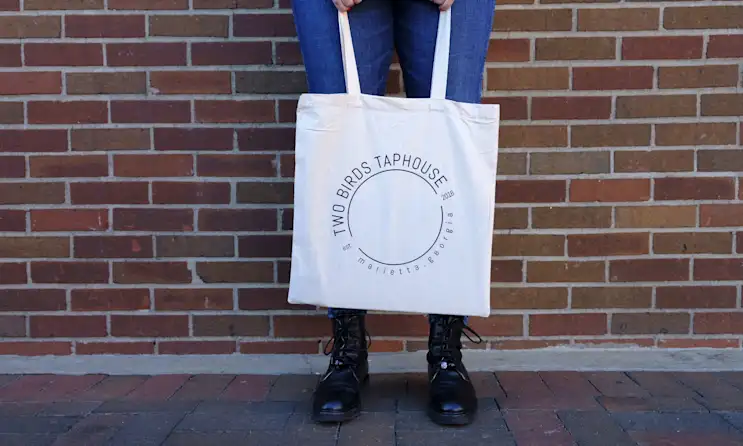
Marketing
10 Restaurant Marketing Tactics to Try in 2024
March 15, 2022
In the modern landscape, restaurants need to test new tactics and measure what moves the needle.
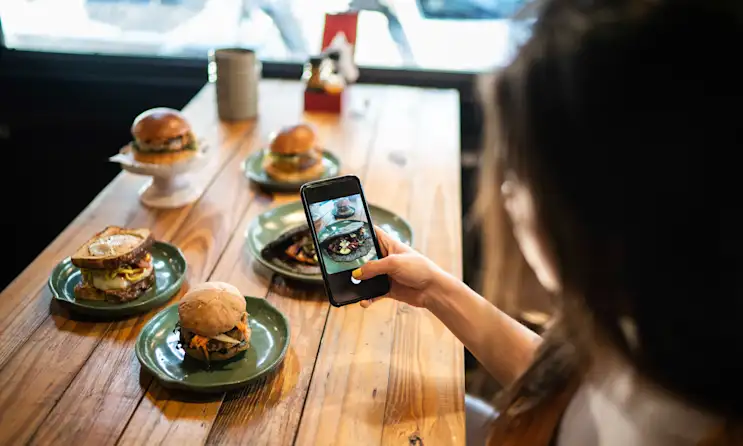
Marketing
A Restaurant’s Guide to Influencer Marketing
February 1, 2023
Influencer marketing should be part of your restaurant’s overall marketing strategy. Here’s how to get started and find the right collaborations.

Marketing
A Beginner's Guide to Restaurant Email Marketing
November 2, 2022
Find out why you should be using email in your marketing efforts, the first five steps to complete and best practices for success.
